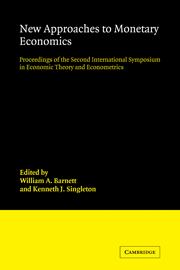 New Approaches to Monetary Economics
New Approaches to Monetary Economics Book contents
- Frontmatter
- Contents
- Editors' introduction
- List of contributors
- Part I Transactions motivated monetary holdings in general equilibrium
- Part II Financial intermediation
- Part III Monetary aggregation theory
- 6 The microeconomic theory of monetary aggregation
- 7 Monetary asset separability tests
- 8 Money demand in open economies: a Divisia application to the U.S. case
- 9 Aggregation of monetary goods: a production model
- 10 Money in the utility function: an empirical implementation
- 11 Comment on papers in Part III
- Part IV Issues on aggregate fluctuations
- Part V Theoretical issues in the foundations of monetary economics and macroeconomics
7 - Monetary asset separability tests
Published online by Cambridge University Press: 04 August 2010
- Frontmatter
- Contents
- Editors' introduction
- List of contributors
- Part I Transactions motivated monetary holdings in general equilibrium
- Part II Financial intermediation
- Part III Monetary aggregation theory
- 6 The microeconomic theory of monetary aggregation
- 7 Monetary asset separability tests
- 8 Money demand in open economies: a Divisia application to the U.S. case
- 9 Aggregation of monetary goods: a production model
- 10 Money in the utility function: an empirical implementation
- 11 Comment on papers in Part III
- Part IV Issues on aggregate fluctuations
- Part V Theoretical issues in the foundations of monetary economics and macroeconomics
Summary
Introduction
A rapidly growing line of research has recently begun to appear on the rigorous use of microeconomic and aggregation-theoretic foundations in the construction of monetary aggregates. Much of the attention derives directly or indirectly from Barnett's (1980a) challenging paper, where he voiced objections to simple-sum aggregation procedures and derived the theoretical linkage between monetary theory and index number theory. He applied economic aggregation and index number theory to construct monetary aggregates based upon Diewert's (1976) class of “superlative” quantity index numbers. The new aggregates are Divisia quantity indexes, which are elements of the superlative class.
A number of recent works have provided a sharp quantitative assessment of the relative merits of summation versus Divisia monetary quantity indexes. Barnett, Offenbacher, and Spindt (1984), for example, compared the empirical performance of Divisia and simple-sum monetary aggregates in terms of various policy criteria such as causality, information content of an aggregate, and stability of money demand equations. Their main finding is the better performance of Divisia aggregates, especially at high levels of aggregation. Similarly, Serletis and Robb (1986) estimate the degree of substitutability between the services of money and checkable savings and time deposits (over institution types) in a quasihomothetic translog utility framework. They investigate both summation and Divisia aggregation of the assets, and provide evidence further supporting the superiority of the Divisia aggregates.
A totally unresolved problem, however, is the method by which monetary assets are selected to be included in the monetary aggregate.
- Type
- Chapter
- Information
- New Approaches to Monetary EconomicsProceedings of the Second International Symposium in Economic Theory and Econometrics, pp. 169 - 182Publisher: Cambridge University PressPrint publication year: 1987
- 9
- Cited by
